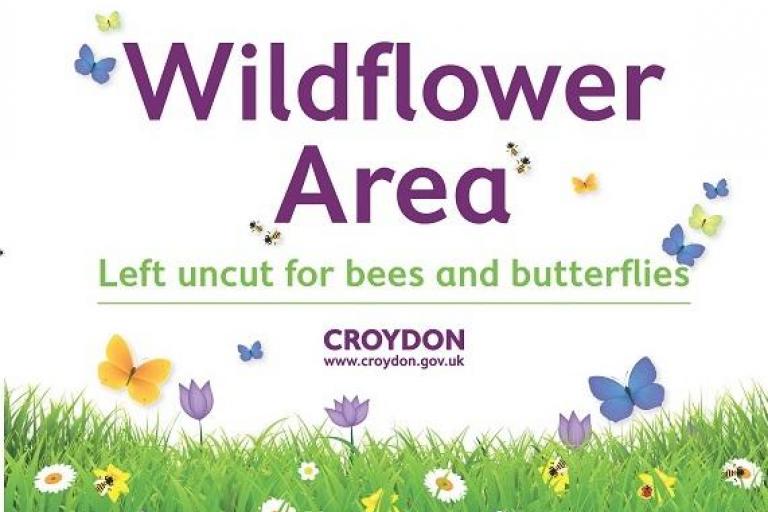Wildflower verge trials
Wildflower verge trials and change in grass cutting regime
Encouraging and protecting bees and butterflies in Croydon

Croydon’s Ground Maintenance Team manages 126 parks and open spaces, about 40ha of housing greens and over 430miles of road/highway verges.
The declared climate emergency and increasing and varied pressures on resources makes it necessary to look at alternative ways to manage the green fabric across the borough.
Bees and butterflies are important pollinators which play a key role in sustaining the flora and fauna of the British island.
About a third of all species of wild bees, bumblebees and hoverflies are in decline due to habitat loss and pesticide use.
As a local authority Croydon manages a huge expanses of grassland for the enjoyment and use by the local community, without the use of pesticides. Some of these areas are already known to provide a colourful display of native flora every year. For example the rich and diverse chalk meadows in the new South London Downs National Nature Reserve. But many of the grass areas in parks or smaller areas such as road verges could be managed differently to provide habitats and green corridors for bees and butterflies.
The council decided that a new grass management approach was needed across the borough to
- Create green highways to establish new and connect existing habitats that are good for pollinators such as bees and butterflies.
- Increase biodiversity in our parks
- Lock in Carbon – Grasslands soils provide the highest carbon lock of any UK broad habitat2 (NEA, 2011)
- Reduce maintenance cost, while still fulfilling our statutory obligations
- Reduce our carbon footprint
The Ground Maintenance Team will achieve this by
- Modifying the grass cutting regime in parks and along road verges to reduce the nutrient value to encourage the emergence of native wild flowers. Sites will be cut twice during the growing season and all arisings collected to remove nutrients from the soil. This will take a number of seasons to achieve the desired result but once wild flowers are established the areas will only receive a cut & remove once a year. The amount of cut grass will reduce over time as the nutrient level reduces.
- Trial wildflower seeding in less species rich areas by a method called ‘hydroseeding’, one of the most effective techniques to introduce new species into existing grassland. Turf will be removed or the grass cut very low to prepare the ground to give the seeds the best chance to establish. These areas will be cut once a year in September and all arisings removed.
A number of trial areas have been chosen to test the feasibility of the new grass management approach. These areas will be monitored during the growing season to measure success and to evaluate if the scheme can be extended across other sites in the borough
Identified trial areas for hydro-seeding:
- Covington Way along boundary with Norwood Grove, Upper Norwood (North)
- The Green, Featherbed Lane, Forestdale (East)
- Bradmore Green, Coulsdon (South)
- Beaulah Road, Thornton Heath (Central)
Different seed mixture will be used to match the sub soils at these sites. Native wildflowers are not always the most colourful but are the best suited to benefit our local pollinators and adapted to grow well in the respective sub soil present.
Trial areas will be clearly marked by a sign saying “Wildflower Area –left uncut for bees and butterflies”
Trees for Bees
The council’s Tree and Woodland Team is working closely with the Ground Maintenance Team to complement the works to create green highways for wildlife to move across the borough. The service is committed to considering the planting of flower and nectar rich species good for wildlife, where possible along road verges and in Croydon’s Parks and Open Spaces.
For more information contact parks@croydon.gov.uk
Beautiful Butterfly Project
The London Wildlife Trust has received a £1 million Dream Fund Award, from the players of the People’s Postcode Lottery to deliver a two year project to create new homes for butterflies and insects through the creation and restoration of chalk grassland, a rare and threatened habitat many species thrive in.
London Wildlife Trust, Butterfly Conservation and the Natural History Museum will be working together with volunteers and local communities to create chalk grassland ‘Living Landscapes’ that will come alive with butterflies, wildflowers and insects.
This is also an excellent opportunity for residents to volunteer and work alongside specialist scientists to survey the areas using pioneering environmental DNA analysis technology and capture data about chalk grassland wildlife, as well as learn new skills in conservation, all whilst spending quality time outdoors. For more information please email: brilliantbutterflies@wildlondon.org.uk
The project is working closely with Croydon Council to maximise the efforts to improve habitats and creating green corridors in the borough for bees and butterflies well beyond the project lifespan.
